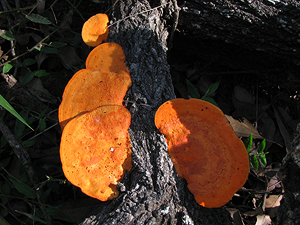
Leucocoprinus birnbaumii (© V Ryan)
Mycology is the study of fungi. Macro-fungi are visible without magnification, micro-fungi are not. The part of the fungus that is seen is the fruit-body, which can be beautiful and fascinating. The actual fungus is not seen, but consists of a mass of threadlike structures called hyphae that weave throughout the substrate (soil, wood, lawn, mulch, leaf litter, animal dung etc.) in which it grows.
Fungi are often thought to be plants, but they aren’t. Fungi cells have walls that contain chitin, unlike the cell walls of plants which contain cellulose. In that respect, fungi are more closely related to animals than plants. Even so, fungi are classified in a Kingdom of their own – Fungi, which is separate from Plants, Animals, and Bacteria.
Some fungi are symbiotic with a living plant. The fungal hyphae and the plant rootlets work together to provide each other with the necessities for life. The fungus gets carbohydrates from the plant, the plant gets an enhanced supply of minerals and water from the soil. This is called a “mycorrhizal association”.
Many precious garden plants fail to thrive because a fungus is not growing near the plant. Research suggests at least 85% of plants require a mycorrhizal association with a specific fungus.
Some fungi are saprotrophic. These fungi break down and recycle dead or dying plant or animal material, releasing vital nutrients, particularly carbon and nitrogen, into the soil. A few fungi are parasitic and can be harmful to the host.
Toxicity: All fungi, except those grown and marketed commercially, should be regarded as potentially poisonous to humans. Some information on toxicity is in the Queensland Government publication: “Plants and fungi poisonous to people in Queensland”.

(© V Ryan)
Some people give fungi “common names”, but as common names vary from region to region, scientific names are preferred. Scientific names consist of a genus, like a surname “Smith”, and a species, which is like a given name, but written all in lower case “john”. They are in that order – Genus species, or using our example Smith john. For scientific identification, most fungi need microscopic study, so “sp.” is used to show that the particular fungus belongs in that particular genus, but its species has not been identified.
Given the important role of fungi in the biodiversity of our world it is regrettable that Mycology is a poorly funded, little known, and a minimally researched area of science. Very few mycologists are employed in Australia and the percentage of Australian macro-fungi that have been described is not known, but it is considered that many fungi are yet to be found and identified. There is a whole world of fungi out there waiting to be discovered.
